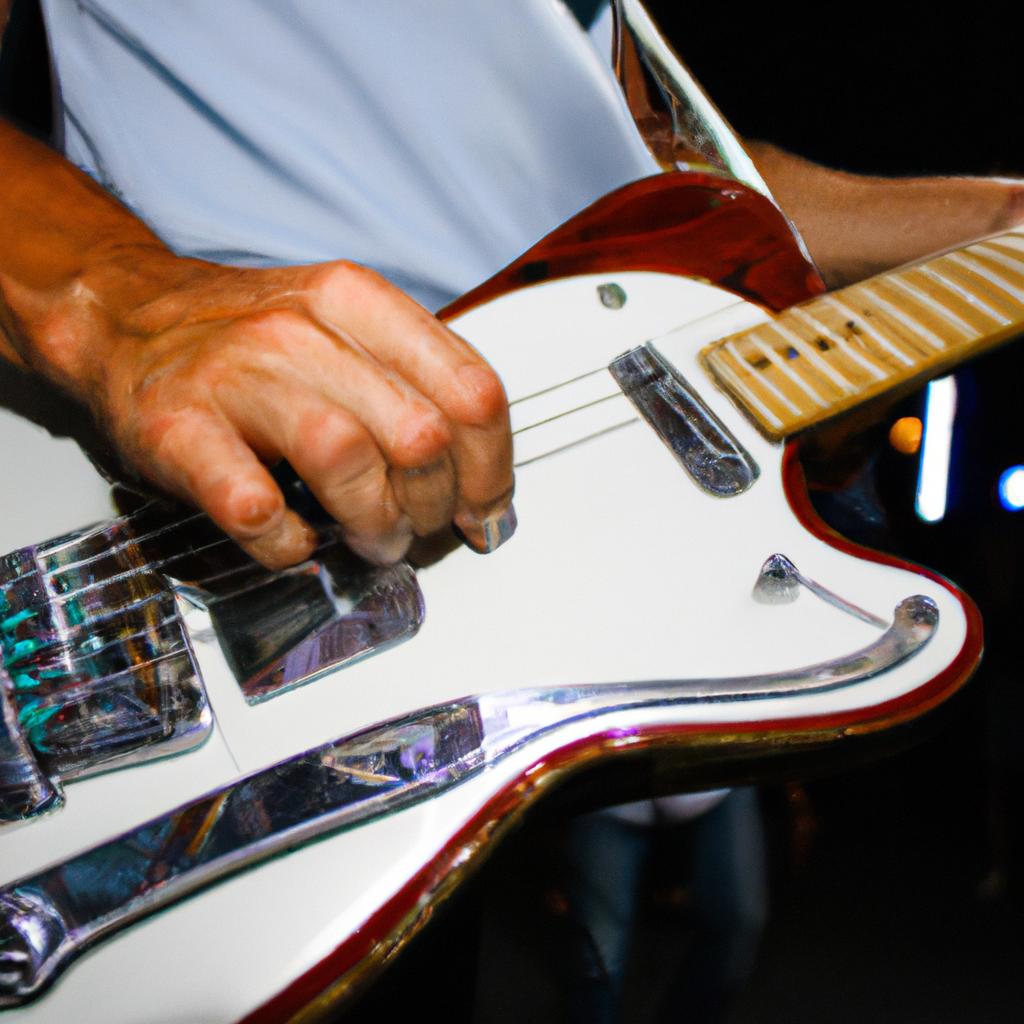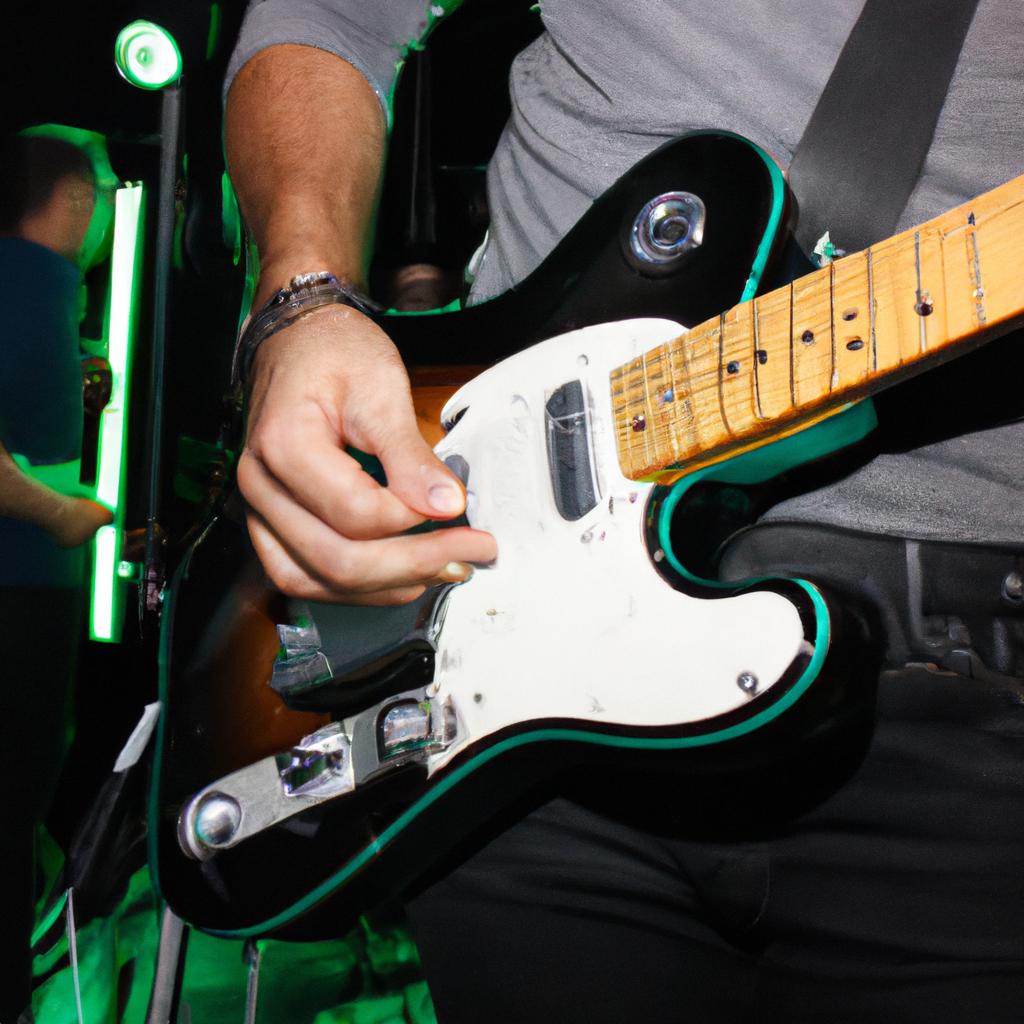Sound engineering is a crucial aspect of live performances, ensuring that the audience experiences optimal sound quality and an immersive musical experience. For musicians like Jose Carlos Matos, understanding the fundamentals of sound engineering can greatly enhance their performances. This article aims to provide a comprehensive guide on sound engineering for live performance within the context of Jose Carlos Matos’ music.
Consider the scenario where Jose Carlos Matos is preparing for his highly anticipated concert at a renowned venue. As he rehearses with his band, they realize that certain instruments are overpowering others and there is an imbalance in the overall sound mix. This is where sound engineering comes into play – it involves techniques such as adjusting audio levels, equalization, and spatial placement to create a harmonious blend of sounds. By delving deeper into the intricacies of sound engineering, musicians like Jose Carlos Matos can take control over their sonic output during live performances, ultimately leaving a lasting impression on their audience.
It is important for musicians like Jose Carlos Matos to understand various aspects of sound engineering in order to optimize their performance outcomes. Therefore, this article will explore key concepts such as microphone selection and placement, signal processing techniques including compression and reverb, and system optimization strategies for achieving balanced and clear audio reproduction in different venues and performance settings.
Microphone selection and placement play a crucial role in capturing the desired sound of each instrument or vocalist. Different microphones have unique characteristics that can enhance or alter the tone and texture of the source. For example, dynamic microphones are durable and suitable for high sound pressure levels, making them ideal for instruments like drums or guitar amplifiers. On the other hand, condenser microphones are more sensitive and offer a wider frequency response, making them suitable for vocals or acoustic instruments.
Once the appropriate microphone is selected, its placement becomes crucial to achieve optimal sound capture. Placing microphones close to the sound source can result in a more direct and focused sound, while placing them farther away can create a more ambient or spacious feel. Experimenting with different placements during rehearsals allows musicians like Jose Carlos Matos to find the sweet spot for each instrument or vocal.
Signal processing techniques such as compression and reverb further shape the overall sound mix during live performances. Compression helps control dynamic range by reducing louder sounds and boosting softer ones, resulting in a smoother and more balanced audio output. It is often used on vocals to ensure consistent levels throughout the performance. Reverb adds depth and dimension by simulating natural acoustics, giving instruments or vocals a sense of space within the venue.
System optimization strategies are essential to achieve clear audio reproduction in different venues and performance settings. This involves understanding the venue’s acoustics, speaker placement, and equalization adjustments to compensate for any room resonances or deficiencies. Additionally, proper monitoring systems should be implemented on stage so that musicians can hear themselves clearly without relying solely on their personal monitors.
In conclusion, sound engineering is an indispensable aspect of live performances for musicians like Jose Carlos Matos. By mastering microphone selection and placement techniques, utilizing signal processing tools such as compression and reverb effectively, and implementing system optimization strategies, musicians can take control over their sonic output during live performances. This comprehensive guide on sound engineering for live performance aims to empower musicians like Jose Carlos Matos to deliver exceptional and immersive musical experiences to their audience.
Understanding the Basics of Sound Engineering
To illustrate the importance of sound engineering in live performances, let’s consider a hypothetical scenario. Imagine a music concert where the lead vocalist’s microphone suddenly stops working during a crucial solo part. The audience becomes disengaged and frustrated, as they can no longer hear the performer clearly. A skilled sound engineer would swiftly identify and fix the issue, ensuring that the show continues smoothly and leaving both the artist and audience satisfied.
A successful live performance heavily relies on various aspects of sound engineering. From setting up equipment to adjusting levels during the show, every detail matters in creating an immersive auditory experience for listeners. Here are some key elements to consider:
- Balance: Achieving a harmonious mix between different instruments and vocals is essential. It requires expertise in adjusting volume levels, panning sounds across speakers, and equalizing frequencies to avoid overpowering or muffled audio.
- Clarity: Ensuring clear articulation of words and melodies enhances listener engagement. Techniques such as proper microphone placement, eliminating unwanted background noise, and managing stage monitors contribute significantly to achieving clarity.
- Dynamics: Understanding how to control dynamics adds depth and emotion to musical performances. Skillful use of compression, limiting, and other dynamic processing tools allows musicians to emphasize certain parts while maintaining overall balance.
- Effects: Utilizing effects like reverb or delay helps create ambiance and enhance specific moments within songs. Applying these effects tastefully – neither too subtle nor overwhelming – enriches the sonic character of a live performance.
Consider this table showcasing emotions evoked by different sound qualities:
| Quality | Emotion |
|---|---|
| Warmth | Comfort |
| Crispness | Excitement |
| Punchiness | Power |
| Spatiality | Immersion |
In summary, understanding the basics of sound engineering is vital for delivering high-quality live performances. By balancing different audio elements, ensuring clarity and dynamics, and effectively incorporating effects, sound engineers contribute significantly to the overall experience of both artists and audiences. In the subsequent section on “Choosing the Right Equipment for Live Sound,” we will delve into how equipment selection plays a crucial role in achieving optimal sound quality during live performances.
Choosing the Right Equipment for Live Sound
Now, let’s delve deeper into choosing the right equipment for live sound to ensure an unforgettable experience for both performers and audiences alike.
Imagine a scenario where Jose Carlos Matos is preparing for a music concert at a large venue. He wants his audience to hear every note and feel fully immersed in the performance. To achieve this, he must carefully consider several factors when selecting his sound equipment:
-
Venue size: Different venues require different types and sizes of equipment. For instance, a small intimate setting may only need a compact PA system with fewer speakers, whereas a larger venue would necessitate more powerful speakers to fill the space adequately.
-
Acoustics: The acoustic properties of each venue play a crucial role in determining what type of audio equipment you should use. A room with poor acoustics may require additional sound treatment or specialized microphones to reduce unwanted echoes or reverberations.
-
Genre/style of music: Different genres or styles of music have unique sonic characteristics that can influence your choice of equipment. For example, if Jose specializes in electronic dance music (EDM), he might prioritize subwoofers and high-frequency tweeters to enhance bass drops and crisp treble sounds.
-
Budget constraints: It’s essential to consider budget limitations while purchasing sound equipment without compromising on quality. Prioritizing key components such as microphones, mixing consoles, and amplifiers will allow Jose to allocate funds wisely within his budget.
To further illustrate these considerations, take a look at the table below showcasing how various factors impact decision-making regarding sound equipment selection:
| Factor | Impact |
|---|---|
| Venue Size | Determines the power requirements |
| Acoustics | Influences choice of audio treatment |
| Music Genre | Dictates specific speaker requirements |
| Budget | Affects the range and quality of options |
By carefully analyzing these factors, Jose can make informed decisions when choosing his sound equipment. With the right selection, he ensures that every note is heard crystal clear, creating an unforgettable experience for his audience.
By following proper techniques and understanding the importance of stage layout, Jose can maximize the impact of his chosen sound equipment without compromising on quality or aesthetics.
Setting Up the Stage for Optimal Sound
In the previous section, we discussed the importance of choosing the right equipment for live sound. Now, let’s delve into another crucial aspect of sound engineering for live performance – setting up the stage for optimal sound.
To illustrate this point, imagine a scenario where an acoustic band is performing in a small venue with poor acoustics. Despite having top-notch equipment, they struggle to achieve a balanced and clear sound due to the unfavorable environment. This highlights the significance of proper stage setup in ensuring an excellent sonic experience for both performers and audience alike.
When setting up the stage for optimal sound, consider these key factors:
- Stage orientation: Positioning instruments and amplifiers strategically can help minimize interference between different sources, reducing audio clashing.
- Microphone placement: Proper microphone technique plays a vital role in capturing each instrument or vocalist accurately without sacrificing clarity or introducing unwanted feedback.
- Monitor mix optimization: Ensuring that performers receive a well-balanced monitor mix tailored to their individual needs can greatly enhance their ability to deliver a captivating performance.
- Acoustic treatment: Implementing basic acoustic treatment measures such as using baffles or absorptive materials can help mitigate excessive reverberation and improve overall sound quality on stage.
Now, let’s take a moment to explore how implementing some practical strategies can contribute to achieving ideal stage setup:
| Stage Orientation | Microphone Placement | Monitor Mix Optimization | Acoustic Treatment |
|---|---|---|---|
| Arrange instruments according to their volume levels | Place microphones close enough but avoid proximity effect | Tailor monitor mixes based on performer preferences | Use portable diffusers near reflective surfaces |
| Minimize positioning conflicts among loudspeakers | Utilize appropriate polar patterns for various sources | Incorporate personal monitoring systems if feasible | Apply bass traps in corners to reduce low-frequency buildup |
| Consider line of sight for musicians | Experiment with microphone positioning to find optimal sound capture | Communicate effectively with performers during rehearsals | Use gobos or screens to isolate instruments and reduce bleed |
By implementing these strategies, you can create an environment where each instrument and vocalist has its own sonic space while still blending harmoniously together. This will result in a more immersive experience for both the performers on stage and the audience.
In our next section, we’ll discuss achieving balanced sound levels and mix, which is crucial in ensuring that every element of your live performance comes together seamlessly.
Achieving Balanced Sound Levels and Mix
In the previous section, we explored the importance of setting up the stage for optimal sound during live performances. Now, let us delve into another crucial aspect: achieving balanced sound levels and mix to ensure an exceptional auditory experience for both the performers and audience.
To illustrate this point, consider a hypothetical scenario where Jose Carlos Matos is performing at a large outdoor music festival. As he takes center stage with his band, it becomes evident that proper sound balance must be achieved to prevent any instrument or vocal from overpowering others. This requires careful attention to various factors throughout the performance.
Firstly, understanding each instrument’s frequency range is essential in obtaining a well-balanced mix. By identifying which frequencies should occupy specific sonic spaces, such as bass occupying lower frequencies and vocals occupying mid-range frequencies, an engineer can effectively adjust individual channel levels accordingly. This practice ensures that no element dominates over others while preserving clarity and definition within the overall sound.
Furthermore, utilizing appropriate panning techniques adds depth and dimension to the audio landscape. By strategically placing instruments across the stereo field, engineers create a more immersive listening experience. For instance:
- Guitars could be panned slightly left and right.
- Keyboards may sit more centered.
- Drums could have different elements spread out between channels.
By implementing these techniques thoughtfully, engineers enhance not only the sense of space but also contribute to an engaging musical journey for listeners.
Finally, employing dynamic processing tools like compressors and limiters helps control inconsistencies in volume levels. These processors act as safeguards against sudden peaks or fluctuations in audio signals by reducing amplitude variations. Skillful use of these tools allows for greater control over dynamics while maintaining consistent output levels throughout the performance.
To summarize:
- Understanding instrument frequency ranges
- Utilizing strategic panning techniques
- Employing dynamic processing tools
By following these practices diligently, sound engineers can achieve an impeccable mix, ensuring that every musical element is heard and appreciated to its fullest potential.
As we move forward into the next section on dealing with feedback and troubleshooting, it becomes paramount for sound engineers to possess a thorough understanding of how to address any technical challenges that may arise during live performances. From managing unwanted audio interference to swiftly resolving equipment malfunctions, adeptly handling these issues contributes significantly to the overall success of a live performance.
Dealing with Feedback and Troubleshooting
Section: Troubleshooting Sound Issues during Live Performances
Imagine this scenario: you are the sound engineer for a live performance by an up-and-coming band. The crowd is excited, and the atmosphere is electric. As the first song starts, everything seems to be going well until suddenly, there is an annoying high-pitched screeching sound coming from the speakers. This is a classic case of feedback, one of the many challenges that can arise when handling sound engineering for live performances.
To ensure a smooth and flawless experience for both the performers and the audience, it’s essential to address these issues promptly. Here are some strategies to help troubleshoot common sound problems:
-
Identify the source of feedback: Feedback occurs when amplified sound loops back into the microphone or instrument pickups. To locate the source quickly, try reducing volume levels on individual microphones or instruments while listening for changes in pitch or intensity.
-
Adjust equalization (EQ) settings: EQ adjustments can be made using graphic or parametric equalizers to control specific frequencies at various points within your audio system. By identifying problematic frequency ranges causing feedback and making targeted reductions in those areas, you can minimize unwanted noise.
-
Positioning equipment strategically: Proper placement of microphones, monitors, and speakers can significantly reduce feedback potential. Experiment with different positions to find optimal locations that minimize interference between sources.
-
Use notch filters: Notch filters allow you to target narrow frequency bands prone to feedback without affecting overall audio quality drastically. These filters attenuate specific frequencies where feedback occurs most frequently.
| Common Feedback Causes | Solutions |
|---|---|
| Microphone proximity effect | Adjust microphone positioning; use directional microphones if appropriate |
| Inadequate monitor placement | Realign monitors away from microphones; consider in-ear monitoring systems |
| Equipment grounding issues | Check cables and connections for proper grounding; use ground lift adapters if necessary |
| Acoustic feedback from the venue | Use sound absorption materials or adjust speaker placement to reduce reverberation |
By employing these troubleshooting strategies, you can minimize sound issues and ensure a high-quality audio experience for both performers and audience members.
Transition:
With a solid understanding of how to troubleshoot common sound problems, let’s now delve into methods that can enhance the sound experience for your audience.
Enhancing the Sound Experience for the Audience
After understanding how to deal with feedback, it is important to explore techniques for enhancing the sound experience for the audience. Let us consider a hypothetical case study involving a rock band performing in a large outdoor venue. Despite meticulous planning and preparation, technical difficulties can still occur during live performances.
One common issue that may arise is poor stage monitor placement. In this scenario, the musicians on stage are unable to hear themselves clearly, leading to an imbalanced performance. To overcome this challenge, it is crucial to ensure that stage monitors are strategically positioned so that performers can hear their own instruments and vocals effectively. By conducting thorough sound checks prior to the show and making necessary adjustments, such as angling the monitors appropriately towards each musician’s position on stage, these issues can be mitigated.
To further enhance the overall sound experience for the audience, consider implementing the following strategies:
- Use high-quality microphones: Investing in reliable microphones designed specifically for live performances ensures clear and crisp audio transmission.
- Employ dynamic EQs: Utilize dynamic equalizers to automatically adjust frequency levels based on input signals, allowing for more consistent sound quality throughout the performance.
- Utilize digital signal processing (DSP) units: DSP units offer advanced capabilities such as reverb effects or noise reduction algorithms which can significantly improve audio clarity during live shows.
- Engage experienced sound engineers: Employing skilled professionals who have extensive knowledge of different genres and venues will help troubleshoot any unforeseen challenges that may arise during performances.
In order to illustrate these strategies more comprehensively, refer to Table 1 below:
| Strategies | Description |
|---|---|
| Use high-quality microphones | Invest in top-notch microphones specifically designed for live performances |
| Employ dynamic EQs | Make use of dynamic equalizers that automatically adjust frequency levels based on input signals |
| Utilize digital signal processing (DSP) | Take advantage of DSP units for advanced capabilities such as reverb effects or noise reduction algorithms |
| Engage experienced sound engineers | Employ skilled professionals who possess extensive knowledge and expertise in troubleshooting live performance sound issues |
Table 1: Strategies to Enhance Sound Experience
By implementing these strategies, performers can ensure a more immersive and enjoyable sonic experience for the audience. An investment in proper equipment, along with the expertise of experienced individuals in the field, will greatly contribute to resolving any technical difficulties that may occur during live performances.
Note: It is advised to regularly update the table’s content based on current industry trends and advancements.
 Jose Carlos Matos
Jose Carlos Matos



